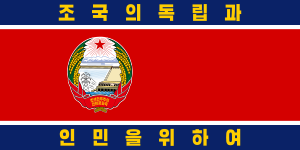الجيش الشعبي الكوري
| Korean People's Army | |
|---|---|
| 조선인민군 | |
 Emblem of the Korean People's Army | |
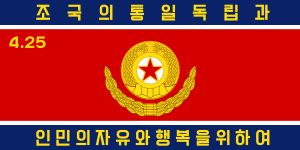 The KPA has not had a discrete flag of its own since 1993; however the flag of the KPA Ground Force is sometimes used to represent the entirety of the KPA.[1] | |
| تأسس | 25 أبريل 1932 |
| الصيغة الحالية | 8 فبراير 1948 |
| فروع الخدمة | |
| المقر الرئيسي | State Affairs Commission, Pyongyang |
| القيادة | |
| Vice Chairman of the Central Military Commission | |
| Minister of Defence | |
| Chief of the General Staff | |
| Director of the General Political Bureau | |
| العديد | |
| سن التجنيد | 17–30 |
| التجنيد | 18 |
| الأفراد النشطون | 1,280,000[2] (4th ذوي الرتب) |
| أفراد الاحتياط | 600,000[2] |
| النفقات | |
| الميزانية | US$1.6 billion (2018)[3] |
| النسبة من ن.م.ا. | 4.9% (2018)[3] |
| الصناعة | |
| الموردون المحليون | |
| الموردون الأجانب | |
| مقالات ذات صلة | |
| الرتب | Comparative military ranks of Korea |
| 'Korean People's Army' | |
| Chosŏn'gŭl | 조선인민군 |
|---|---|
| هانچا | 朝鮮人民軍 |
| الرومنة المعدلة | Joseon Inmingun |
| مكيون-رايشاور | Chosŏn Inmingun |
| كوريا الشمالية |
 هذه المقالة هي جزء من سلسلة: |
|
|
|
|
|
دول أخرى • أطلس بوابة السياسة |
The Korean People's Army (KPA; الكورية: 조선인민군; م-ر: Chosŏn-inmin'gun; lit. Korean People's Military) is the military force of North Korea and the armed wing of the Workers' Party of Korea (WPK).[4] Under the Songun policy, it is the central institution of North Korean society. Kim Jong-un serves as Supreme Commander and the chairman of the Central Military Commission. The KPA consists of five branches: the Ground Force, the Naval Force, the Air and Anti-Air Force, the Strategic Rocket Forces, and the Special Operation Force.
The KPA considers its primary adversaries to be the Republic of Korea Armed Forces and United States Forces Korea, across the Korean Demilitarized Zone, as it has since the Armistice Agreement of July 1953. اعتبارا من 2021[تحديث] it is the second largest military organisation in the world, with 30.6% of the North Korean population actively serving, in reserve or in a paramilitary capacity.[5][6]
History


Korean People's Revolutionary Army 1932–1948
Korean Volunteer Army 1939–1948
Soviet Korean Units
Formation of National Army
Conflicts and events
Date of establishment history
Organization

Commission and leadership
Ground force formations
- I Corps (Hoeyang County, Kangwon Province)
- II Corps (Pyongsan County, North Hwanghae Province)
- III Corps (Nampo, South Pyongan)
- IV Corps (Haeju, South Hwanghae Province)
- V Corps (Sepo County, Kangwon Province)
- VII Corps (Hamhung, South Hamgyong Province)
- Pyongyang Defense Command
- XII Corps
- IX (Chongjin, North Hamgyong Province)
- X Corps (Hyesan, Ryanggang Province)
- XI Corps (Tokchon, South Pyongan Province)
- Mechanised infantry divisions:
- 820th Tank Corps
Conscription and terms of service
 مقالة مفصلة: التجنيد في كوريا الشمالية
مقالة مفصلة: التجنيد في كوريا الشمالية
Paramilitary organisations
Budget and commercial interests

Service branches
Ground Force
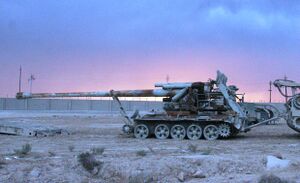

Air and Anti-Air Force
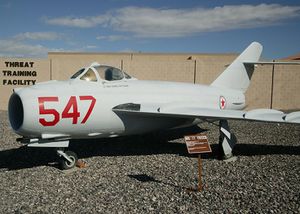
Strategic Rocket Force
Special Operation Force
Capabilities
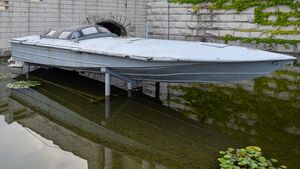
{ر-}}
Military equipment
Weapons
Chemical weapons
Nuclear capabilities
Nuclear tests
- 2006 North Korean nuclear test
- 2009 North Korean nuclear test
- 2013 North Korean nuclear test
- January 2016 North Korean nuclear test
- September 2016 North Korean nuclear test
- September 2017 North Korean nuclear test
Other
- Tonghae Satellite Launching Ground
- Ryanggang explosion
- Yongbyon Nuclear Scientific Research Center
- Songun
- Asymmetric warfare
- The launching of Kwangmyŏngsŏng-3 and Kwangmyŏngsŏng-3 Unit 2 in 2012.
Uniforms
See also
- April 25 Sports Club
- Central Military Band of the Korean People's Army
- Joson Inmingun
- Korean conflict
- Republic of Korea Armed Forces
- Songun
- Worker-Peasant Red Guards
Notes
- ^ Tertitskiy, Fyodor; Hotham, Oliver (10 April 2018). "What North Korea's army flags can teach us about its recent history". NK News. Retrieved 12 November 2018.
..despite some claims, there has been no design for a unified flag for all the Armed Forces since: the DPRK occasionally, however, uses the Ground Forces flag as a substitute to symbolize the entire military.
- ^ أ ب IISS 2019, pp. 280–281.
- ^ أ ب "Military expenditure by country, in constant (2017) US$ m., 1988–2018" (PDF). Stockholm International Peace Research Institute. 2019. Retrieved 2 July 2019.
- ^ "Korean People's Army". globalsecurity.org. Retrieved 16 September 2019.
The Korean People's Army is the "revolutionary armed wing" of the Worker's Party as stated in Article 46 of the party constitution, with first and foremost loyalties to the party.
- ^ UNFPA (1 October 2009). 한반도 인구 7천400만명 시대 임박 (in الكورية). United Nations. Archived from the original on 24 May 2013. Retrieved 21 November 2012.
- ^ "DPR Korea 2008 Population Census: National Report" (PDF). Archived from the original (PDF) on 31 March 2010. Retrieved 19 February 2011.
- ^ Tertitskiy, Fyodor; Hotham, Oliver (10 April 2018). "What North Korea's army flags can teach us about its recent history". NK News. Retrieved 12 November 2018.
The modern design of the flags appeared in 1993, when Kim Jong Il replaced the flag of the KPA with three separate ones for the army, navy, and air force. [...] despite some claims, there has been no design for a unified flag for all the Armed Forces since: the DPRK occasionally, however, uses the Ground Forces flag as a substitute to symbolize the entire military.
References
- International Institute for Strategic Studies (15 February 2019). The Military Balance 2019. London: Routledge. ISBN 9781857439885.
- Bermudez, Joseph S. (2001). Shield of the Great Leader. The Armed Forces of North Korea. The Armed Forces of Asia. Sydney: Allen & Unwin. ISBN 978-1-86448-582-0.
- Homer T. Hodge, "North Korea's Military Strategy", Parameters, Spring 2003, pp. 68–81.
- The International Institute for Strategic Studies (IISS) (2007). The Military Balance 2007. Abingdon: Routledge Journals. ISBN 978-1-85743-437-8.
- Jane's World Air Forces. Issue 25, 2007. Coulsdon: Jane's Information Group.
- Saunders, Stephen (ed.). Jane's Fighting Ships Vol. 110, 2007–2008. Coulsdon: Jane's Information Group.
 This article incorporates public domain material from the United States Army document "North Korea's Military Threat: Pyongyang's Conventional Forces, Weapons of Mass Destruction, and Ballistic Missiles" by Scobell, Andrew; Sanford, John M (retrieved on 8 September 2014). April 2007. Carlisle: Strategic Studies Institute. ISBN 1-58487-286-1
This article incorporates public domain material from the United States Army document "North Korea's Military Threat: Pyongyang's Conventional Forces, Weapons of Mass Destruction, and Ballistic Missiles" by Scobell, Andrew; Sanford, John M (retrieved on 8 September 2014). April 2007. Carlisle: Strategic Studies Institute. ISBN 1-58487-286-1- North Korea Country Study (PDF). Library of Congress. 2009.
Further reading
- Bermudez, Joseph S. (1998). North Korean special forces. Annapolis: Naval Institute Press. ISBN 978-1-55750-066-3.
- Boik, William A. (2008). Orders, Decorations, and Medals of the Democratic People's Republic of Korea. Springfield, VA: DBMPress.com. ISBN 978-0-615-19087-7.
- Mitzer, Stijn; Oliemans, Joost (2015). North Korea's Armed Forces: On the Path of Songun. Solihull: Helion. ISBN 978-1-910777-14-5.
وصلات خارجية
- CS1 uses الكورية-language script (ko)
- CS1 الكورية-language sources (ko)
- Short description matches Wikidata
- Articles containing كورية-language text
- Articles containing Korean-language text
- مقالات فيها عبارات متقادمة منذ 2021
- جميع المقالات التي فيها عبارات متقادمة
- Articles with hatnote templates targeting a nonexistent page
- Articles with unsourced statements from October 2017
- Pages with empty portal template
- Wikipedia articles incorporating text from the United States Army
- Wikipedia articles incorporating text from public domain works of the United States Government
- عسكرية كوريا الشمالية
- Military units and formations established in the 1940s
- Workers' Party of Korea
- History of the Workers' Party of Korea
- Military wings of political parties

